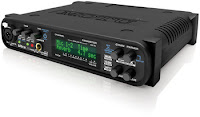Sunday, April 17, 2011
Blue Spark
Sunday, April 3, 2011
Neve Portico II

Sunday, March 20, 2011
In the studio with Tim Church
I had some time to sit down with tim while he was recording some of his next album with us at fragile studios usa.
Heres a little bit of our interview on how he finds his guitar tones!
So how do you go about finding that amazing tone you have?
Mostly it’s a trial and error for me but there’s no right or wrong way to do it. I start with whatever general I’m going after. Basically just “to distort or not to distort and how much to distort?” are the first questions. After that I’ll slowly tweak each knob on the amp to get a ground tone before adding any effects like reverb or chorus. Personally, I like more Mids in my tone than anything else so I’ll start with that and the Treble. I do those at the same time because I want to cut through the mix but with the Mids too high, the tone becomes muddled and it’s hard to tell exactly what you’re doing. Adjusting the Treble really helps a lot but again with too much, you start to lose the integrity of the tone. After I’ve got a good punch in my sound I’ll round it out with low end. This just makes it easier on the audiences’ ears when you go up for that high note at the end of a solo. Just because the note you’re playing is high, doesn’t mean it has to hurt so I guess keep that in mind ha-ha.
How about when approaching the layers of effects you could add to a tone?
I don’t really worry about adding effects unless a song I’m writing calls for it but if you are happy with your base tone, any effect you add on top of that will sound good as far as the tone is concerned.
Now when writing a song, Is it the tone for the song or vice versa?
The song is the most important part for me, so obviously the tone I choose to use is directly affected by it. Lets just say Eric Johnson’s Zap inspired a riff or chord progression. I would at that point go to that song and emulate the tone he had during the part that inspired me. That would be my base tone for writing the rest of the song and if need be, I would add or take away certain aspects of the tone to compliment the progression.
Any advice for people with multiple amps or people with practice amps?
When creating a tone, I keep in mind the amp I’m using. It’s pointless to experiment with tone on your 15 watt practice amp unless that is the amp you’ll be using to perform live or record with. The second you go into the studio and use a different amp, you’ll be wasting your time and money fiddling because it doesn’t sound right.
Now how do you feel about pedals Vs. Rack effects that are after your amp?
I don’t really believe in putting any effects between your guitar and your amp. It sucks the base tone dry. If you do have a lot of effects in your signal path, make sure to set up your base tone with your rig completely set up. That way, what you hear while making the tone, is what you hear when running different effects on top of it.
Anything else for the kidos?
A lot of what I do is really just common sense if you think about it. Don’t overcomplicate things. Simplicity is key to greatness when thinking this stuff out.
Sunday, February 20, 2011
Manley VOXBOX

MANLEY transformers w/nickel laminations in mu-metal cases
2 Kohm MIC INPUT Z w/High current 48V Phantom power built-in
Hi-Z (100K) Direct Instrument Input
LINE & INSERT INPUTS (balanced XLR & 1/4")
PREAMP & EQ outputs LO-Z (50W)
Transformer balanced XLR outputs
Transformerless unbalanced 1/4"outputs
STEREO LINK for Compressor & De-esser/Limiter
SIDE CHAIN MONITOR for De-Esser
Large ILLUMINATED Sifam METER with FIVE readout modes - (older units before serial number MVB**1359 shipped before 9/2003 use: 12V 1.2W FESTOON LAMPS; Manley's Part Number: VAR016C) Order spare bulbs using our parts order form. (newest units after serial number MVB**1359 shipped after 9/2003 use yellow LED lighting)
THD + N (1KHz @ +20 dBu): 0.3%
Maximum output: +31dBu
Sunday, February 6, 2011
Best Audio interface for what you do!

